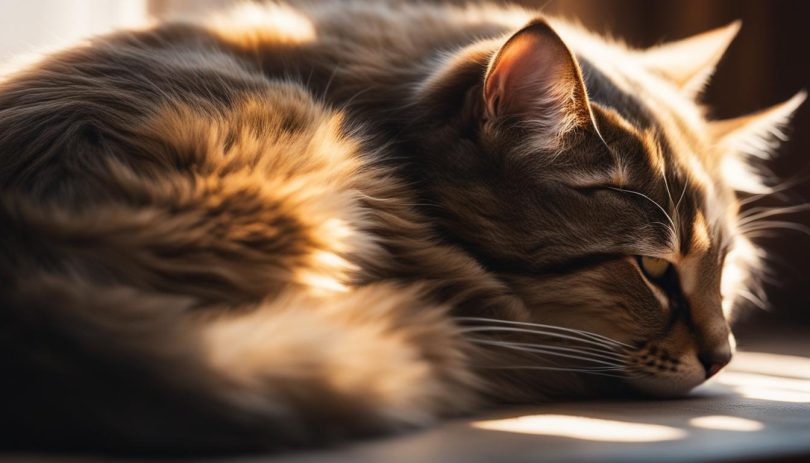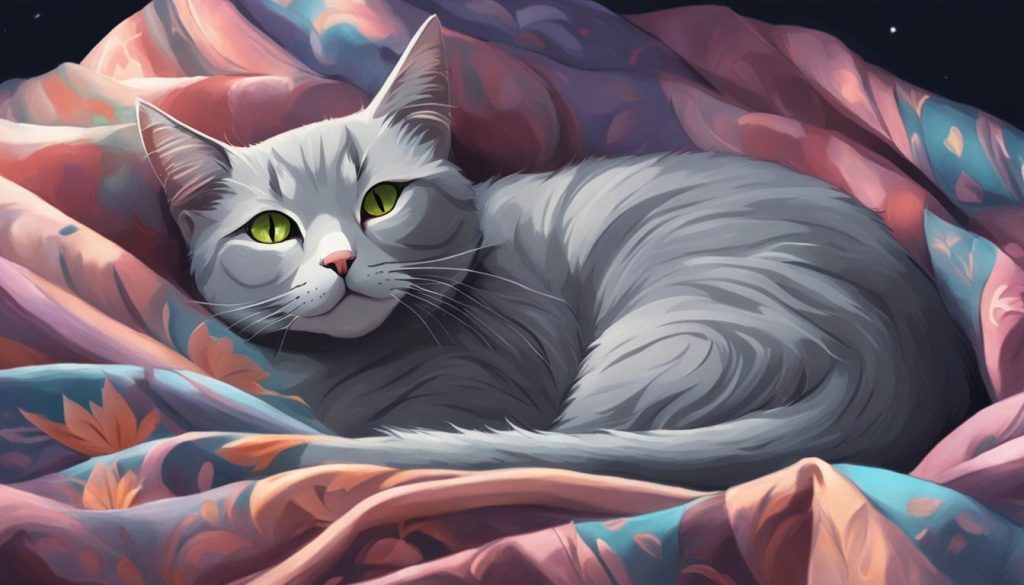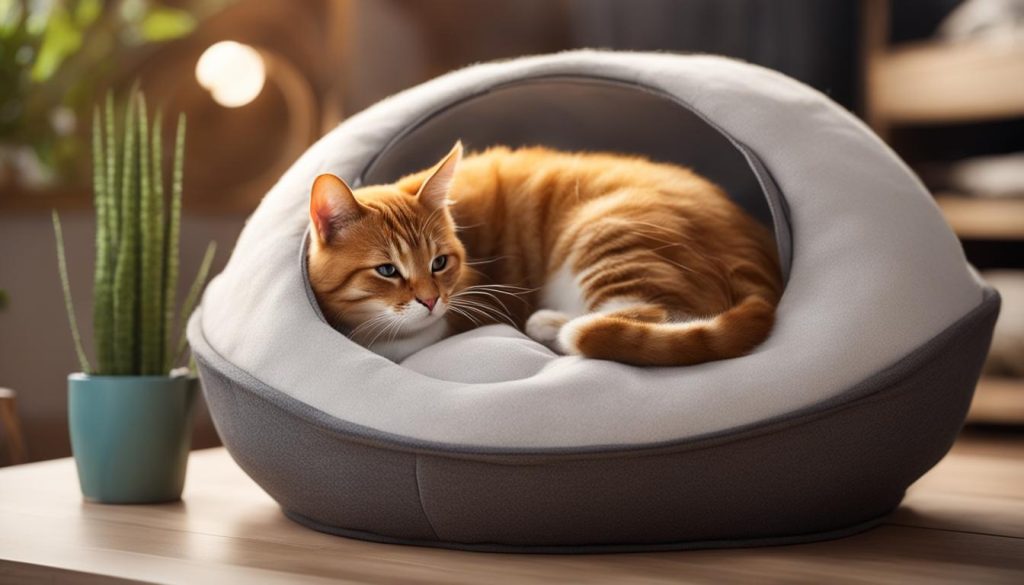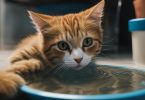Cats are fascinating creatures when it comes to sleep. They have a unique ability to curl up into a ball while they snooze, but have you ever wondered why they sleep in this peculiar position? In this article, we will explore the reasons behind cats’ curled-up sleep and unravel the mystery behind their sleeping habits.
Key Takeaways:
- Understanding the science behind feline sleep patterns can help provide the best care for your cat.
- Cats sleep in a ball to conserve body heat, protect vital organs, and quickly spring into action if needed.
- Observing and respecting your cat’s sleep habits is crucial for their overall well-being.
- Creating a comfortable sleep environment and maintaining a consistent sleep schedule can enhance your cat’s sleep quality.
- By prioritizing your cat’s sleep, you can help them stay healthy and happy.
The Evolutionary Purpose of Cat Naps
Cats’ sleeping habits, particularly their tendency to sleep in a curled-up position, have evolutionary roots. This behavior can be traced back to their ancestry as natural predators. Cats, both wild and domesticated, instinctively curl up to conserve energy and stay hidden from potential predators. Sleeping in a ball helps cats retain body heat and protect their vital organs during rest. It also allows them to quickly spring into action if needed, ensuring their safety in their surrounding environment.
This cat nap instinct is deeply ingrained in feline DNA and has been passed down through generations. Even though domesticated cats don’t need to hunt for their survival, they still exhibit this instinctual behavior. Curling up to sleep provides them with a sense of security and comfort, allowing them to relax deeply and rejuvenate their bodies.
The Benefits of Cat Naps
The evolutionary purpose of cat naps goes beyond conservation of energy and protection. Cats’ curled-up sleep positions also serve as a way to maintain comfort and security. By curling up, cats can conserve body heat more efficiently and create a warm and cozy environment for themselves. This behavior is particularly useful during colder months or when cats need to sleep in unfamiliar or exposed areas.
In addition to physical benefits, curled-up sleep also has psychological advantages for cats. It allows them to feel safe and secure, reducing anxiety and promoting relaxation. By understanding the evolutionary purpose of cat naps and the benefits of their curled-up sleep positions, we can appreciate why this is their preferred sleeping position and provide them with the necessary comfort and support they need.
Common Cat Sleeping Positions and What They Mean
When it comes to cat sleep behavior, the positions they choose can reveal a lot about their mood and personality. Understanding these positions can give us insight into their emotions and help us better understand our feline friends. Let’s take a look at some common cat sleeping positions and what they mean:
The Loaf Position:
The loaf position is when a cat curls up with its tail tucked in. This position is a sign of calmness and contentment. When a cat sleeps in the loaf position, it indicates that they feel safe and secure in their environment. It’s a position that cats use to relax and recharge.
The Belly-Up Position:
Have you ever seen a cat sleeping on its back with its belly exposed? This is known as the belly-up position. When a cat sleeps in this position, it signifies a deep sense of relaxation and trust. By exposing their vulnerable belly, cats are showing that they feel completely at ease.
The Curled-Up Position:
One of the most common cat sleeping positions is the curled-up position. This is when a cat sleeps in a tight ball, with their paws tucked underneath their body. Cats adopt this position to conserve body heat and feel secure. However, it’s important to note that if a cat is consistently sleeping in a tight ball and showing signs of anxiety or stress, it may be a cause for concern.
The Sprawled Out Position:
On the opposite end of the spectrum, some cats prefer to sleep sprawled out. This position is a display of dominance and confidence. When a cat sleeps with its legs stretched out and takes up a lot of space, it’s a sign that they feel secure in their territory.
It’s important to remember that every cat is unique, and their sleeping positions may vary. Observing your cat’s sleep behavior can help you better understand their needs and emotions. By providing a comfortable and safe sleep environment, you can ensure that your cat gets the quality rest they need to thrive.
The Science Behind Feline Sleep Patterns
Understanding the science behind feline sleep patterns is essential for providing the best care for your cat. Cats have distinct sleep cycles consisting of non-rapid eye movement (NREM) sleep and rapid eye movement (REM) sleep. NREM sleep helps restore and repair tissues, while REM sleep is crucial for brain restoration and function. During REM sleep, cats may exhibit twitching or paw movements, indicating increased brain activity. This stage of sleep is vital for memory consolidation and learning.
Cats spend the majority of their day sleeping, with their sleep cycles varying in length and intensity. On average, cats sleep for 12 to 16 hours per day. Their sleep patterns can be influenced by factors such as age and health conditions. Older cats may experience more disrupted sleep and have shorter REM sleep cycles.
To ensure your cat gets quality sleep, it’s important to provide a comfortable sleep environment. This includes a quiet and cozy sleeping area, free from disturbances. Investing in a high-quality cat bed with soft, supportive bedding can enhance your cat’s sleep quality. Additionally, observing your cat’s sleep patterns and respecting their preferences can contribute to their overall well-being.
Table: Comparison of NREM and REM Sleep in Cats
| Sleep Stage | Description | Function |
|---|---|---|
| NREM Sleep | Characterized by slow brain waves and muscle relaxation | Restores and repairs tissues |
| REM Sleep | Characterized by rapid eye movements and increased brain activity | Restores brain function, memory consolidation, and learning |
By understanding the science behind feline sleep patterns and providing the appropriate care, you can help your cat maintain optimal sleep health for a happy and vibrant life.
How Age Affects a Cat’s Sleep
As cats age, their sleep patterns undergo changes. Just like humans, older cats tend to spend more time sleeping compared to their younger counterparts. They may experience alterations in their sleep cycles, including a decrease in the amount of rapid eye movement (REM) sleep they get. REM sleep is crucial for memory consolidation and brain function, so these changes can have an impact on their cognitive abilities.
Additionally, age-related health conditions such as arthritis or kidney disease can disrupt a cat’s sleep. Discomfort or pain can make it challenging for senior cats to find a comfortable position and get quality rest. As a result, they may exhibit restless sleep or increased waking during the night.
To help support an aging cat’s sleep, it’s important to observe their sleep patterns and make necessary adjustments. Providing a comfortable and supportive sleep environment, such as a soft bed or cushion, can help alleviate any discomfort. Creating a quiet and peaceful space for them to sleep in can also contribute to their overall sleep quality. If you notice any significant changes in their sleep patterns or excessive sleep disturbances, it’s best to consult with a veterinarian to rule out any underlying health issues.
| Sleep Pattern | Description |
|---|---|
| Increased sleep duration | Older cats may spend more time sleeping compared to younger cats. |
| Decreased REM sleep | Senior cats may experience a decrease in the amount of REM sleep they get, which can impact their cognitive abilities. |
| Restless sleep | Age-related health conditions such as arthritis or kidney disease can cause discomfort, leading to restless sleep or increased waking during the night. |
By understanding how age affects a cat’s sleep and taking steps to provide them with a comfortable sleep environment, you can help ensure that your senior cat gets the restful sleep they need to maintain their well-being.
The Role of REM Sleep in Cats
REM sleep, or rapid eye movement sleep, plays a crucial role in the mental health and overall well-being of cats. During REM sleep, cats experience increased brain activity, and they may exhibit twitching or paw movements. This stage of sleep is responsible for memory consolidation and learning, making it essential for a cat’s cognitive function. Cats who are deprived of REM sleep may experience impaired learning and memory retention.
REM sleep is particularly important for cats as it helps them process and store information. Like humans, cats dream during this stage of sleep. Their dream behavior, such as twitching or making soft noises, is a reflection of their mental activity during REM sleep. It’s fascinating to observe these dream behaviors and see how the cat’s mind is active even while they are sleeping.
“REM sleep in cats is crucial for memory consolidation and learning. Depriving cats of REM sleep can have detrimental effects on their cognitive abilities.”
Understanding the significance of REM sleep in cats allows us to appreciate the importance of providing them with a proper sleep environment. By ensuring they have a comfortable and secure place to sleep, we can support their REM sleep and contribute to their overall mental well-being. It’s important to create a quiet and peaceful space for cats to sleep, free from disturbances that could disrupt their sleep cycles and REM sleep.
Observing and respecting a cat’s sleep habits, including their REM sleep, is crucial for their health and happiness. By providing them with the right conditions and allowing them to have undisturbed sleep, we can help our feline friends thrive both mentally and physically.
| Benefits of REM Sleep in Cats | Impaired REM Sleep Effects |
|---|---|
| Memory consolidation | Impaired learning |
| Learning and cognitive function | Memory retention issues |
| Mental health and well-being | Reduced cognitive abilities |
The Social Aspects of Cat Sleep
When it comes to cat sleep behavior, it’s not just about finding a cozy spot and curling up. Sleeping can also have social benefits for our feline friends. Cats are known for their independent nature, but they are also social animals that form bonds with their human companions and other cats. Just like humans, cats seek comfort and security in their social connections, and sleeping together is one way they reinforce those bonds.
Observing cat sleep positions can give us insights into their social relationships. Cats who sleep close to each other, whether it’s curled up together or simply in the same room, are fostering their social bonds. This behavior is especially common in group-living situations where cats rely on each other for safety and companionship. When cats feel safe and secure in their environment, they are more likely to sleep peacefully and deeply, contributing to their overall well-being.
To ensure our cats have a positive sleep environment that supports their social connections, it’s important to provide comfortable sleeping areas. A cozy bed with soft bedding or a sunny windowsill can create a space where cats feel relaxed and content. By respecting their need for a safe and comfortable sleep environment, we can help our cats maintain positive social connections and promote their overall health and happiness.
| Social Aspects of Cat Sleep | Benefits |
|---|---|
| Formation and reinforcement of social bonds | Building stronger relationships with human companions and other cats |
| Enhanced sense of security | Increased relaxation and deeper sleep |
| Promotion of overall well-being | Improved physical and mental health |
Image source: seowriting.ai
How to Ensure Your Cat Gets Quality Sleep
Ensuring your cat gets quality sleep is essential for their overall well-being and happiness. By creating a comfortable sleep environment and observing their sleep habits, you can help your feline friend rest peacefully. Here are some tips to ensure your cat gets the best sleep possible:
1. Provide a Comfortable Cat Bed
Investing in a high-quality cat bed is crucial for your cat’s sleep quality. Look for a bed that is soft, supportive, and the right size for your cat. Cats appreciate having their own space to curl up and feel safe. Consider the materials of the bed, ensuring it is cozy and warm without being too hot, especially in the summer months.
2. Create a Quiet and Dark Sleep Environment
Cats are sensitive to their surroundings, so it’s important to create a sleep environment that is quiet and dark. Choose a location for their bed away from noisy areas, such as the kitchen or entrance. Use curtains or blinds to block out any excessive light that could disturb their sleep. This will help create a calm and peaceful atmosphere for your cat to rest.
3. Observe and Respect Their Sleep Patterns
Observing your cat’s sleep patterns is key to understanding their individual needs. Cats have their own sleep preferences and habits, so it’s important to respect them. If you notice your cat likes to sleep in a certain spot or position, try to accommodate their preferences. Cats feel most comfortable when they can sleep undisturbed, so avoid waking them or disturbing their sleep unnecessarily.
| Sleep Habit | Description |
|---|---|
| Curled-Up | Cats sleep in a ball to conserve body heat and feel secure. |
| Stretching Out | Cats who sleep sprawled out demonstrate confidence and relaxation. |
| Loaf Position | Curling up with tail tucked shows contentment and calmness. |
By understanding and respecting your cat’s sleep habits, you can ensure they get the quality rest they need to stay healthy and happy.
Remember that each cat is unique, and their sleep needs may vary. By providing a comfortable sleep environment, observing their sleep patterns, and respecting their preferences, you can help your cat enjoy peaceful and restful sleep.
The Benefits of Curled-Up Sleep for Cats
When you see your cat curled up in a ball, it’s not just an adorable sight—it’s also a reflection of their innate instincts and the various benefits that this sleep position provides. Cats naturally gravitate towards the curled-up position for several reasons, including comfort, safety, and maintaining body heat.
One of the main benefits of curled-up sleep for cats is comfort. By curling up, cats can create a cozy and secure environment that helps them relax deeply and feel safe. This position allows them to conserve body heat, as they tuck their paws and tail close to their body, keeping themselves warm even in cooler temperatures.
Additionally, the curled-up position enables cats to quickly spring into action if needed. By protecting their vital organs, such as their abdomen and chest, cats can easily assume a defensive pose or be ready to pounce on prey. This instinctual behavior harks back to their evolutionary roots as natural hunters.
Understanding the benefits of curled-up sleep for cats is essential for providing them with the necessary comfort and support they need. By observing your cat’s preferred sleep position and providing a cozy bed or cushion, you can ensure they get the quality rest they require to stay healthy, happy, and fully recharge for their adventurous days ahead.
The Benefits of Curled-Up Sleep for Cats:
- Comfort: The curled-up position provides cats with a cozy and secure environment, allowing them to relax deeply and feel safe.
- Body Heat Conservation: By tucking their paws and tail close to their body, cats can conserve body heat and stay warm, even in cooler temperatures.
- Quick Response: Curling up helps cats protect their vital organs and allows them to quickly assume a defensive pose or be ready to pounce on prey.
Observing and Respecting Cat Sleep Habits
When it comes to our beloved feline friends, understanding their sleep habits is essential for building a strong bond and ensuring their overall well-being. Cats have unique sleep behaviors and preferences that should be observed and respected. By creating a suitable sleep environment and paying attention to their individual needs, we can make sure our cats get the restful sleep they require.
Observing Cat Sleep
Observing our cats while they sleep can provide valuable insights into their overall health and happiness. Take note of their favored sleep positions, such as curled up in a ball or stretched out in full relaxation. Notice if they have any difficulties falling asleep, toss and turn, or exhibit signs of restlessness. By understanding their individual sleep patterns, we can detect any changes or discomfort that may require attention.
Respecting Cat Sleep Preferences
Respecting our cats’ sleep preferences is crucial for their well-being. Cats are creatures of habit, and disruptions to their sleep routine can cause stress and anxiety. Provide a quiet and cozy sleep environment, away from noisy areas or high-traffic zones. Respect their need for solitude and avoid waking them abruptly during their naptime. By honoring their sleep preferences, we can ensure they feel safe and secure.
Creating a Cat-Friendly Sleep Environment
Creating a cat-friendly sleep environment is essential for promoting quality rest. Consider providing a comfortable and supportive cat bed with soft bedding that appeals to their natural instincts. Ensure the sleep area is clean, free from any potential hazards or discomforts. Additionally, consider placing the sleep area in a spot that cats find appealing, such as near a window for sunlight or in a secluded corner for privacy.
Remember, each cat is unique, and their sleep habits may vary. By observing and respecting their sleep preferences, we can strengthen our bond with them and contribute to their overall health and happiness. Providing a cat-friendly sleep environment and the necessary space for uninterrupted rest is the key to ensuring our furry companions get the quality sleep they deserve.
Conclusion
After delving into the fascinating world of cat sleep, we have gained a deeper understanding of their sleep patterns, behaviors, and habits. Cats truly are unique creatures when it comes to their slumber. From their curled-up positions to their various sleep cycles, every aspect of their sleep serves a purpose.
By recognizing why cats sleep in a ball and the significance of their sleep positions, we can better care for our feline companions. It is essential to respect their sleep habits and provide them with a comfortable sleep environment that meets their needs.
Remember, observing their sleep behaviors and ensuring they get quality rest are vital for their overall well-being. So, the next time you see your cat curled up in a ball, take a moment to appreciate their natural sleep instincts and the care they are taking to ensure their own happiness and health.
FAQ
Why do cats sleep in a ball?
Cats sleep in a ball to conserve body heat, protect their vital organs, and stay hidden from potential predators. It is a natural instinct that provides them with comfort and security.
What do different cat sleeping positions mean?
Different cat sleeping positions can indicate their mood and personality. For example, a curled-up position indicates a sense of security, while sleeping belly-up shows relaxation and trust. However, every cat is unique, and their sleeping positions may vary.
How do cat sleep patterns work?
Cats have sleep cycles consisting of non-rapid eye movement (NREM) sleep and rapid eye movement (REM) sleep. NREM sleep helps restore tissues, while REM sleep is important for brain restoration and memory consolidation. Cats spend around 12 to 16 hours per day sleeping.
How does age affect a cat’s sleep?
As cats age, their sleep patterns may change. Older cats may sleep more and experience disruptions in their sleep cycles. Age-related health conditions can also affect their sleep. Observing and monitoring an older cat’s sleep patterns is important for their comfort and well-being.
What is the role of REM sleep in cats?
REM sleep plays a crucial role in cats’ mental health and cognitive function. It is responsible for memory consolidation and learning. Cats who are deprived of REM sleep may experience impaired learning and memory retention.
Is cat sleep social?
Yes, sleeping in close proximity to each other helps cats form and reinforce social bonds, especially in group-living situations. Feeling safe and secure in their environment contributes to their overall sleep quality and well-being.
How can I ensure my cat gets quality sleep?
Creating a comfortable sleep environment is essential. Provide a quiet, dark, and cozy sleeping area with a high-quality cat bed. Respect your cat’s sleep preferences and maintain a consistent sleep schedule. Observing their sleep patterns will help you understand their needs.
Why do cats prefer curled-up sleep?
Cats prefer curled-up sleep for comfort, safety, and warmth conservation. It allows them to relax deeply and quickly react if needed. Providing a supportive and cozy bed will ensure your cat gets the necessary comfort they need.
How can I build a strong bond with my cat through sleep habits?
Observe and respect your cat’s sleep habits. Cats thrive on routine and can become stressed if their sleep patterns are disrupted. Providing a quiet, cozy sleeping area and respecting their need for solitude will help you build a strong bond with your cat.
Why are cat sleep patterns so fascinating?
Cat sleep patterns are complex and serve important functions for their physical and mental well-being. Understanding their sleep behaviors and needs allows us to provide the best care for our feline friends.








